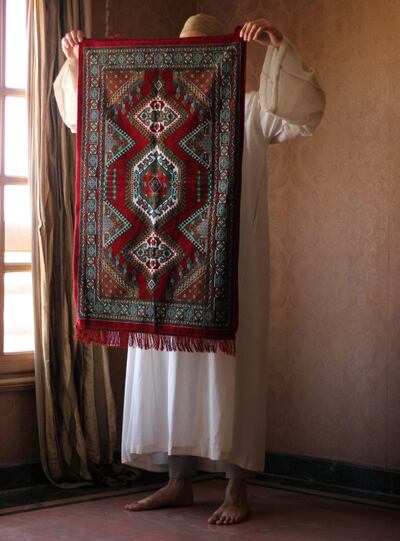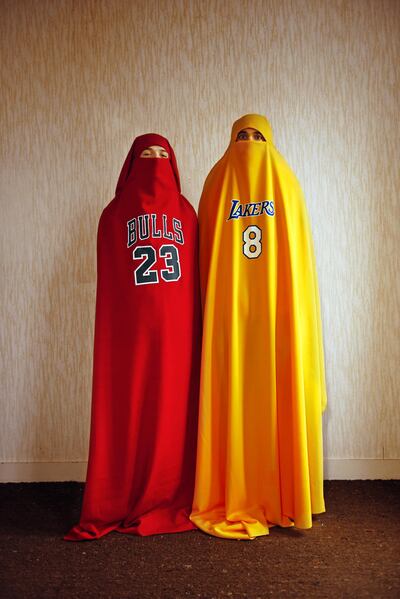Standing barefoot in the corner of a rose gold wallpapered room, Ebrahim Bahaa-Eldin holds up his prayer rug by its edges. Soft sunlight streams in from the window beside him. He is wearing a thobe and a taqiyah, but we can’t see his face.
We don’t know anything about Bahaa-Eldin besides his name and the fact he lives in Cairo. But he isn’t the primary subject of the image he has sent to the Belgian-Moroccan photographer Mous Lamrabat. His prayer rug is.
Bahaa-Eldin was one of the hundreds who responded to Lamrabat’s photography prompt this Ramadan. The photographer knew that Ramadan 2020 was going to be different.
Many mosques around the world were closed due to the coronavirus pandemic. Going to the homes of friends and family for iftar was rarely an option. For many, the community aspect of the holy month had been affected.
Lamrabat felt this, and so sought to connect with other fasters around the world, which is why he put a photo-prompt on his Instagram page. He was expecting to get a few dozen replies at best. He got up to around 100 a day.
"When I saw that a lot of people were sad about how Ramadan was going to be during the lockdown I immediately knew I wanted to do something with the people," he tells The National. "Just to give everybody the feeling of connection and also to motivate people."
Scroll through below, and in the gallery above, to see more of the works:
Lamrabat chose to keep his prompts straightforward, advising everyone to raise their prayer rugs by the corners in a way to cover their face. “I wanted to keep the instructions simple so everyone would get encouraged to participate. I always wanted to do a project with prayer rugs because they are so, so beautiful. The aesthetics and colours are very unique. Especially when you have a lot of them together.”
Photographs started pouring into his email’s inbox. Fifty on the first day, 60 on the second, and then about a 100 a day for the next few weeks.
“People were very enthusiastic to participate. It was very touching how many wrote to me, saying it had been a while since they had had this much fun... whether with their parents or their children. The emails also made me realise how many people had to spend Ramadan on their own, and that it was a very lonely period for them. They said the project made them feel like we were all working on something together.”
Lamrabat says he would love to exhibit the photographs in mosques all over the world. But the photographer is keeping his expectations on this front in check.
“To have a couple of [the works] hanging in a mosque would mean so much to me. Most of the images are very pure and there is nothing that could be considered haram.
"But I know that this is a dream because it would take tons of effort to realise it. I have never seen an exhibition in a mosque, so I thought it was a great idea,” Lamrabat says, adding that he doesn’t intend for the works to be exhibited in prayer halls but rather “in the space where we take off our shoes, for example. So people that go to pray can also enjoy the work.”
Subverting the brand
Lamrabat's other work leans towards the fashion world, while retaining a distinctly Arab flair. In October 2019, the Belgian-Moroccan photographer had a solo exhibition in Abu Dhabi's Manarat al Saadiyat. The exhibition, titled East to East, featured subjects wearing taqiyahs and thobes, faces draped with Gucci, Adidas and Burberry fabrics.
Brand symbols are a recurring motif in Lamrabat’s photographs. One of his works feature two people in chadors, one is yellow with the Los Angeles Lakers logo and Kobe Bryant’s eight, the other has Michael Jordan’s 23 under the Chicago Bulls’ lettering. Other works for him feature the McDonalds brand. But the logo that is most prominently featured in Lamrabat’s works is the Nike swoosh.
“I played basketball for a long time when I was young. Do you know how tough it is for a kid seeing all your teammates wearing Nikes and Jordan sneakers and you are wearing brandless running shoes? I mean there are more horrible things in the world, but for a kid that’s tough,” he says.
“I remember one game I played with boots because I didn’t have sport-sneakers. I was so ashamed. So I love sneakers now, I’m obsessed with the Nike logo now just because I was so obsessed about it as a kid. And that’s also why I still use it a lot in my photography today.”
However, Lamrabat doesn’t want his viewers to think he is endorsing these brands or sharing a positive message about the corporations.
“We live in a world in which brands have become very important, especially fashion brands,” he says, adding that a considerable number of people around the world are trying to work in fashion or become fashion influencers.
“So when I use a brand’s logo, I use it to steal the attention of the viewer. Because, they recognise it, they love it, it’s something familiar. But I never have just the logo in the image,” Lamrabat notes. “Most of the time I try to steal their attention while trying to introduce something new or pass a message to them. It’s a bit of a sneaky way, but it does the job!”
What's next for him?
Lamrabat, above, is currently looking to carve brand logos on the husks of the distinctly round and spongy Moroccan bread. The project, which is currently underway, is a collaboration between the artist and his mother.
“For many, bread is such a nostalgic food. Just the smell of it can transport you to your childhood. I’ve always wanted to work with my mother on a project, and I think this is the perfect way to do it. She’ll be making the bread, and I’ll work on carving designs on them. From brand logos like the Nike swoosh to more culturally-inspired patterns.”














